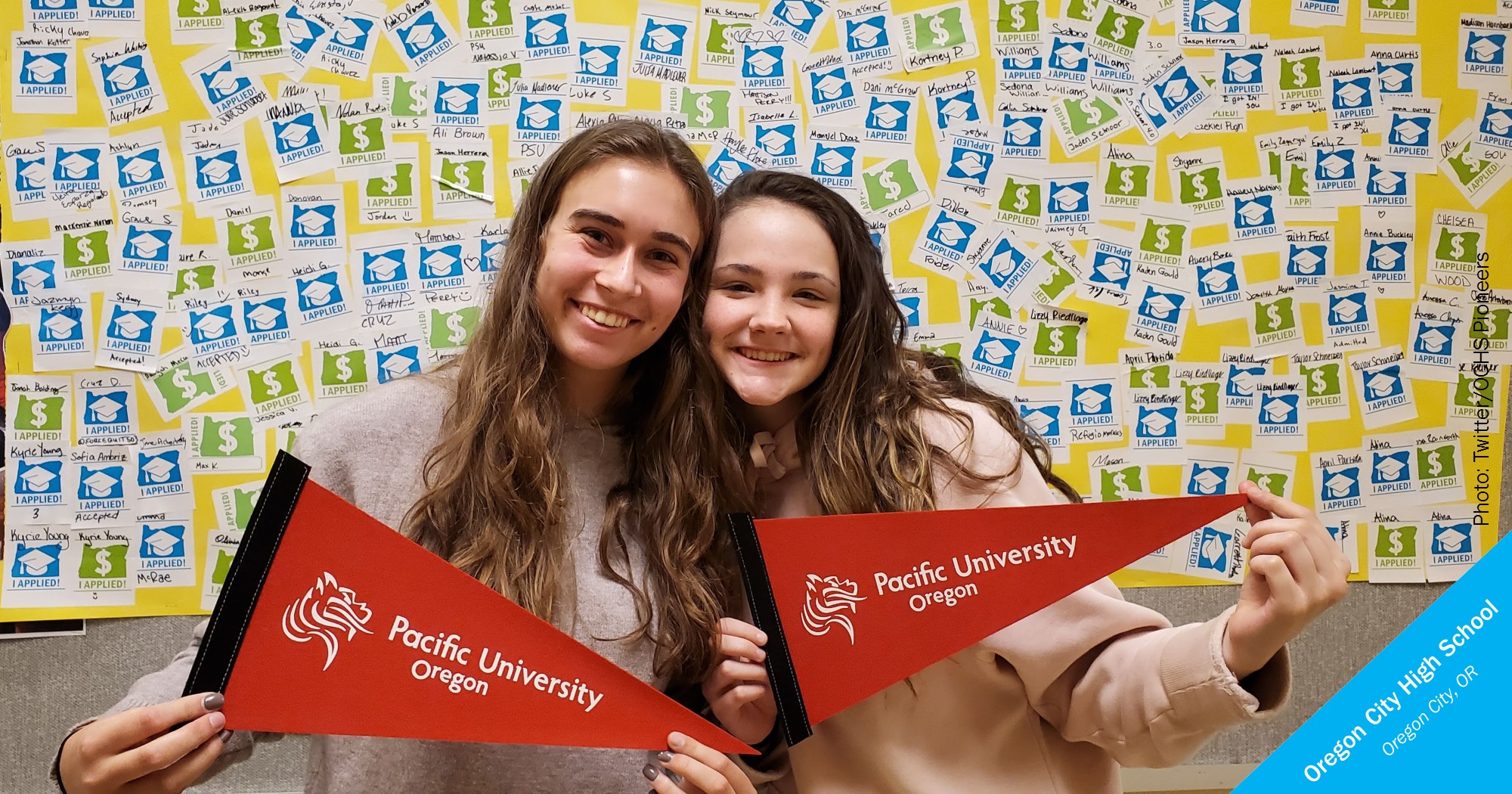
Learn how students can explore options that serve their academic, social and financial needs and interests.
Discover strategies to explore the importance of college fit in every stage of the college choice process for students in middle school through 12th grade.
Table of contents
★ = Oregon Goes To College resource
Why college fit matters
Where students enroll can be just as important as if they enroll. Students are more likely to complete college if they attend an institution that fits their social, academic and financial needs.
Low-income students face several barriers to enrolling in an institution that would be a good fit: late college planning, limited knowledge of college options, limited support in the college choice process and an underestimate of their academic ability as well as capacity to pay for college.
High-achieving, low-income students are especially prone to “undermatch” and end up at a less selective institution. Therefore, educators should aim to provide students with resources and information about college options as early as possible, organize campus visits to a variety of types of institutions, and serve as a constant source of guidance and support.
What is college fit and match?
Fit = student's needs
College fit is the degree to which a college meets a student’s academic, social, financial, and other needs and interests. Fit may be based on a variety of these factors, including location, academic programs, class sizes, graduation and employment rate and support services. Students will encounter a variety of options that meet their needs.
Match = college's needs or requirements
Match, most broadly, refers to the degree that a student meets a college’s needs or prerequisites. Often, it explicitly refers to institutional selectivity or entrance requirements and students’ academic ability. Those who choose to attend an institution with academic indicators (e.g. test scores or average high school GPA) below their own are said to “undermatch”.
The college choice process
It’s important to understand college fit in the context of the college choice process that culminates with a student enrolling in a college that best serves his or her needs. Use our College Fit Planning Guide ★ and the resources and activities that follow to support students through each of these stages.
| College-going identity | College search | College choice |
|---|---|---|
| Grades 7-9 | Grades 10-12 | Grades 11-12 |
| Students begin developing their aspirations for education and careers and begin to consider whether they are college material. | Students receive and sort through information about college and financial aid to develop a list of schools that will be a “good fit”. | Students decide whether they will attend college and if so, where. These decisions may be influenced by whether a school is a “good fit”. |

College-going identity
As students become teens they actively begin developing their sense of identity, trying to answer the question “Who am I?”. You can help students build a positive, college-going identity in a variety of ways.
Define strengths
Help students explore their identity with exercises about their personal values and strengths.
- Believing the College Dream, ECMC
- Choices and Values, Character Plus
- Sparks, Step-It-Up-2-Thrive
- Strengths Test, HIGH 5 Test
- Conversation Starters: Strengths, Search Institute
Set goals
Encourage students to explore different paths for their future and make a plan to reach their goals.
- WOOP Goal Setting Worksheet, Character Lab
- My Story Project, Oregon GEAR UP
- Education Plan & Profile, Oregon Department of Education
Find role models
Provide adult and near-peer mentors to serve as role models and examples for students.
- Alumni Panel ★
- Link Crew, The Boomerang Project
- ASPIRE
- Mentoring.org
Explore college options
Develop a college-going culture in schools and communities and have all adults consistently communicate the expectation of higher education.
Ensure that students and parents have a balanced set of reasons why to go to college and address fears and barriers of attending.
Guide students and parents through basic information about options for postsecondary education, especially the academic requirements for admission and the availability of financial aid.
Provide experiences for students and parents on a variety of college campuses so they can picture themselves as a college student.
College search
Encourage all students to consider their personal preferences and goals for postsecondary education and actively explore a wide variety of colleges.
Examine preferences
Help students examine what living and learning environments they prefer or need and what is a priority in their college experience.
- What is College Fit? Presentation ★
- What is College Fit? Kahoot ★
- College Personality Quiz ★
- College Fit Game ★
- College Personality Quiz, U.S. News
- Finding Your College Fit, BigFuture
- What to Look for in a School, Education Planner
Consider match
Regularly review course requirements and transcripts with students and parents and discuss what postsecondary options will be available to them based on classes, grades and extracurriculars.
- College Admissions Sorting Game ★
- Are You On Track to Get In?, BigFuture
- What You Do In High School Matters, BigFuture
- Transferring from a 2-Year to a 4-Year College, BigFuture
Connect to careers
Help students explore the education they will need for the careers they are interested in.
Explore college options
Guide students and parents through options for college, including how to pay for it and the net price of different types of schools.
Ensure that students and parents understand different types of postsecondary options, especially those that may be unfamiliar to them, such as apprenticeships, career and trades schools, liberal arts schools, women’s colleges, or colleges that serve specific groups like Historically Black Colleges and Universities or Hispanic-Serving Institutions Tribal Colleges and Asian American and Native American Pacific Islander-Serving Institutions.
Have students research and compare colleges based on their preferences, academic record, connection to future careers and financial needs.
- Singled Out: Oregon Colleges ★
- Find Colleges, BigFuture
- College Scorecard, U.S. Department of Education
- College Matchmaker, Forbes
- College Comparison Scorecard ★
Take students and parents on field trips to a variety of institution types (community college, 4-year public, 4-year private, trade school) and have them reflect on what they like and dislike for each.
- Student Campus Visit Checklist, BigFuture
- Campus Visit Scorecard, BigFuture

College choice
Help students narrow their college options and support them through the application and transition process, while continuing to voice high expectations for all students.
Explore college options
Continue sharing information about colleges, the college process and the importance of college fit with students and parents.
Have students narrow their list of colleges to apply to based on their preferences, academic record, connection to future careers and financial need.
- College Comparison Scorecard ★
- How to Finalize Your College List, BigFuture
- Find Colleges, BigFuture
- College Scorecard, U.S. Department of Education
Bring students to college fairs in your area for them to interact with college admissions representatives. Organize field trips to colleges that your students are planning on applying to and/or attending. Encourage students to reflect on how the school’s programs and culture fit their needs and identities.
- Campus Culture Detective ★
- Student Campus Visit Checklist, BigFuture
- Campus Visit Scorecard, BigFuture
- Student College Fair Checklist, BigFuture
Support the process
Support students and parents through the college application process with weekly reminders of key deadlines and tasks and hands-on help completing college and financial aid applications.
- 12th Grade: College Checklists ★
- College Application Week ★
- FAFSA Plus+, OSAC
- Financial Aid Toolkit, Federal Student Aid
Help students review financial aid offers and make a final decision on where to attend college. Celebrate seniors’ postsecondary plans!
- You Got Accepted, Now What? Big Future
- Right Fit Quiz, Set To Go
- Transferring from a 2-Year to a 4-Year College, BigFuture
- Decision Day ★
Address common fears, barriers and challenges that first-year college students face and support students’ transition to college.
- What to Expect from College, BigFuture
